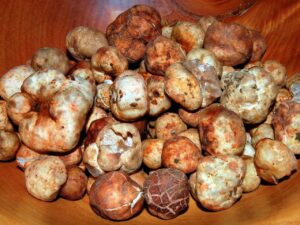Oregonense

Scientific Name
Tuber oregonese
Common Name
Oregon white truffle
Seasons
October – March
Description
Closely related to Tuber gibbosum both in appearance and in distribution, but they have different growing seasons.
Relatively small, typically 0.5-5 cm (0.2-2 in) across, although specimens up to 7.5 cm (3.0 in) have been recorded. Smaller specimens are spherical or nearly so, and have random furrows; larger specimens are more irregular in shape, lobed and deeply furrowed. Young fruit bodies have a white peridium (“skin”), as the truffle matures it develops red to reddish-brown or orangish-brown patches; with age it becomes orange-brown to reddish-brown overall and often develops cracks on the surface. The surface texture ranges from relatively smooth to covered with tiny “hairs” that are more dense in the furrows, and more scattered on the exposed lobes.
The gleba (“flesh”) is solid. In youth the fertile tissue is whitish and marbled with mostly narrow, white, hypha-stuffed veins that emerge throughout the peridium to its surface. In maturity, the fertile tissue is light brown to brown from the color of the spores, but the marbling veins remain white.
Aroma/Flavor
The odor and flavor of the flesh are mild in youth, but soon become strong, pungent and complex, or “truffly”. They are prized for their umami like or slightly garlic or diesel aroma, and they are often used to infuse other ingredients.
Distribution
Found only in the wild in the the Pacific Northwest region of North America (northern California into British Columbia). Dog harvested truffles tend to be of better quality as the dog tend to identify mature truffles. Raking is incriminatory and often results in unreliable crop quality.
See grading guidelines
Other species
- Tuber aestivum (black summer truffle)
- Tubber Borchii (bianchetto)
- Tuber Brumale (Muscato truffle)
- Kalapuya Brunea (Oregon brown truffle)
- Leucangium carthusianum (Oregon black truffle)
- Tuber canaliculatum (Appalachian truffle)
- Tuber gibbosum (Oregon white truffle)
- Tuber lyonii (pecan truffle)
- Tuber macrosporum (smooth black truffle)
- Tuber magnatum (white truffle)
- Tuber melanosporum (Perigord truffle)
- Tuber oregonese (Oregon white truffle)
- Tuber uncinatum (Burgundy truffle)

